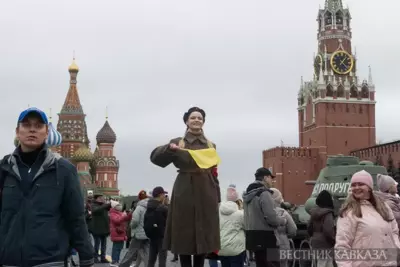By Yuri Glushkov exclusively for Vestnik Kavkaza
The trilateral talks of Presidents Vladimir Putin (Russia), Ilham Aliyev (Azerbaijan) and Serzh Sargsyan (Armenia) in Sochi have not been a breakthrough and only reduced military confrontation. No one expected a breakthrough from Russian peacekeeping anyway. The Russian president focused on pacifying the sides and demonstrating the domination of Moscow in mediating efforts in the South Caucasus.
France had been trying to organize a meeting of the Azerbaijani and Armenian presidents as a co-chair of the OSCE Minsk Group since mid-May. Washington tried to orient the meeting toward September within the framework of a new session of the UN General Assembly. The situation on the Karabakh front in mid-July intensified, Moscow gathered Aliyev and Sargsyan for a meeting with Putin and prevented a new war.
Russia may guarantee peace in Karabakh
What is the secret of such effective Russian diplomacy? Putin’s rating in Baku and Yerevan is as high as in Russia. Armenians and Azerbaijanis understand that countries thousands of kilometers away from the South Caucasus cannot guarantee peace on their lands. Both capitals say that the key to resolving the conflict is in Moscow. But in this situation, additional confrontation in the South Caucasus is absolutely out of place for Russia in the light of the Ukraine crisis. Since the active peacekeeping of Dmitry Medvedev during his presidency, the sides got used to top-level mediation of Russia, Putin’s move was natural and logical for them. Russia does need long-term peace in Karabakh and full-fledged regional economic cooperation.
Some media reported that Russia took advantage of the violence on the Armenian-Azerbaijani border in July-August. Moscow was allegedly trying to add fuel to the conflict to demonstrate the fragility of energy communication to the West. Most of such ideas are spread by Armenian mass media opposed to Armenia joining the Eurasian Union.
In reality, Russia is the party most interested in peace on its borders, hence the determination and diplomatic pressure to calm the sides. Pragmatism and common sense are why Russia wants to keep peace and settle the conflict.
How much does Russia lose in Armenia?
It is no secret that the Armenian economy is devastated. It is in the deepest crisis, isolated from the majority of regional trade because of the unresolved Karabakh conflict. Armenia exported products worth $1.5 billion and imported $4.5 billion worth in 2013, a red ink of $3 billion. The same tendency can be seen this year.
Russia is the main sponsor of Armenia. Over $1.6 billion of cash transfers from Armenians working in Russia were made in 2013. Only $82.1 million were transferred from the U.S., about $250 million from other countries. The sum of about $2 billion could cover only part of the deficit. Other funds were received from Russia as a loan worth $1 billion. Everyone understands that the Russian pocket is finite and cannot patch the budget of another state, even an ally, for long. Moreover, there is no payoff from invested money while the situation in Russia is not very positive.
Assisting Armenia in joining the Customs Union and the Eurasian Economic Union, is a complicated mission for Russia because Armenia has no border with it. Armenia’s strives to join the structures add pressure to Armenian economy and Russian business that controls about half of Armenian economic potential. So, speaking of failure of the Armenian economy, it is necessary to mention losses Russian companies suffer and missing opportunities for profit in the format of mass projects realized in the South Caucasus Region.
What does Russia have in Armenia
Russia’s Gazprom is not the only supplier of gas in Armenia (over 1 billion cubic meters a year). Its subsidiary ArmRosgazprom controls its distribution in the country, largest power plants producing about 80% of electricity.
Russia’s largest state company Rosneft is in fact a monopolist in supplying Armenia with petroleum products (about 350,000 tons a year), considering that customs fees for Russian fuel were lifted in December 2013. Rosneft owns the control package of shares in Armenia’s largest chemical facility Nairit. The Armenian industrial giant specializes in production of synthetic rubber. The alliance of Rosneft and Italy’s Pirelli should revive production. In December 2013, Rosneft, Pirelli Tyre Armenia and Rosneft-Armenia signed a memorandum to form a joint venture to produce rubber at Nairit. The ambitious project requires $400 million of investments.
Mars is the largest Armenia radio-electronic enterprises built in the Soviet times. Russia took control over it in 2002 as a payment for the state debt. Mars specializes in development and implementation of electronic equipment, production of items from non-ferrous metals and plastic. Its assets are controlled by Sintroniks, a high-tech concern of Sistema. Sintroniks Armenia, a subsidiary registered in September 2009, manages other assets Sintroniks took control of from Rosimushchestvo: the Yerevan Science and Research Institute of Automatized Control Systems, NPPM, management of the free economic zone they are located on.
Armenal is the only manufacturer of aluminum foil in the Caucasus and Central Asia. It has been a property of Rusal since 2003 and became one of the most eco-friendly aluminum factories of the world. Russia is represented in the transportation sector: the Russian Railways got concession of the Armenian Railway in 2008, it is still managed by the South-Caucasus Railway. Investments of the Russian Railways total $250 million. The South Caucasus Railway became a self-sufficient enterprise only a few years ago. Borders of Turkey and Azerbaijan closed for Armenia reduce freighting. In reality, the South Caucasus Railway only freights to Georgia, where Ports Poti and Batumi can be used to transport goods to Armenia. About 80% of Armenian products pass Georgia, causing rejoice among Georgian freighters.
VTB, VEB and other banks have Armenian subsidiaries used to finance projects of Russian companies in the country and transfer money of Armenians from Russia.
How to make Armenian economy work
All the mentioned and unmentioned enterprises of Russia are inefficient at a certain scale in Armenia. If status quo of the Karabakh crisis remains, drain of employable population (the population of Armenia is already below 3 million) will only intensify. Making Armenian economy work is only possible by settling the conflict with Azerbaijan.
De-occupation of districts will doubtlessly open borders of Turkey and start economic cooperation with Azerbaijan. Baku has declared several times that it wanted economic cooperation with Armenia after withdrawal of its forces from Azerbaijani districts unrelated to Karabakh.
Russian business, as part of the Armenian economy, his big hopes for that. Russian establishment understands well that inviting Armenia to the Eurasian Union at this point does not make problems simpler because Russia and Armenia have no common border. Speaking of Armenia’s joining an integration structure together or without Karabakh is a completely different story.
Settlement of the Nagorno-Karabakh conflict would give clear results to Russia, in terms of economy. Unblocking transportation would have an enormous synergetic effect on all sectors of the Armenian economy. The South Caucasus Railway would be able to operate in Turkey and Azerbaijan. Cargo sent by Russian suppliers to Armenia could be delivered through Azerbaijan without the need for transshipment at Russian and Georgian ports.
Evaluating potential gains of the Armenian railway can be made basing on the following example: the South Caucasus Railway transported about 3 million tons of cargo in 2013, the Georgian Railway used its transit potential to transport 18 million tons of cargo of Azerbaijan and other Caspian states. Connections with the Turkish railway system would be an important addition for the Baku-Tbilisi-Kars railway route. Transportation would improve efficiency of Armenal and the Zangezur copper facility the control package of shares of which belong to a German company. About half of the 3 million tons of cargo transported by the South Caucasus Railway was copper and related goods.
Gazprom would gain an alternative opportunity to supply Armenia with gas through Azerbaijan. Armenian energy companies controlled by the Russian gas monopoly would gain access to the huge Turkish market that needs electricity. Rosneft would have diversified oil shipments to Armenia, deepening confidential strategic relations with the State Oil Company of the Azerbaijan Republic (SOCAR). Armenia’s Nairit would have been launched using raw materials of Azerbaijan.
Settling the Karabakh conflict would allow realization of mentioned and implicit projects with hundreds of thousands of workplaces for the Armenian economy. Russia and Armenia would make billions. Changing the logistical schemes alone would create new alternatives and markets for sales, reducing expenses of companies and stimulating investment. Yerevan's politicians need to show political will and confirm their determination to do good for their own people. Until then, Russian business will continue counting expenses and losses from property in Armenia.
Russia may make billions from settling the Karabakh conflictBy Yuri Glushkov exclusively for Vestnik KavkazaThe trilateral talks of Presidents Vladimir Putin (Russia), Ilham Aliyev (Azerbaijan) and Serzh Sargsyan (Armenia) in Sochi have not been a breakthrough and only reduced military confrontation. No one expected a breakthrough from Russian peacekeeping anyway. The Russian president focused on pacifying the sides and demonstrating the domination of Moscow in mediating efforts in the South Caucasus.France had been trying to organize a meeting of the Azerbaijani and Armenian presidents as a co-chair of the OSCE Minsk Group since mid-May. Washington tried to orient the meeting toward September within the framework of a new session of the UN General Assembly. The situation on the Karabakh front in mid-July intensified, Moscow gathered Aliyev and Sargsyan for a meeting with Putin and prevented a new war.Russia may guarantee peace in KarabakhWhat is the secret of such effective Russian diplomacy? Putin’s rating in Baku and Yerevan is as high as in Russia. Armenians and Azerbaijanis understand that countries thousands of kilometers away from the South Caucasus cannot guarantee peace on their lands. Both capitals say that the key to resolving the conflict is in Moscow. But in this situation, additional confrontation in the South Caucasus is absolutely out of place for Russia in the light of the Ukraine crisis. Since the active peacekeeping of Dmitry Medvedev during his presidency, the sides got used to top-level mediation of Russia, Putin’s move was natural and logical for them. Russia does need long-term peace in Karabakh and full-fledged regional economic cooperation.Some media reported that Russia took advantage of the violence on the Armenian-Azerbaijani border in July-August. Moscow was allegedly trying to add fuel to the conflict to demonstrate the fragility of energy communication to the West. Most of such ideas are spread by Armenian mass media opposed to Armenia joining the Eurasian Union.In reality, Russia is the party most interested in peace on its borders, hence the determination and diplomatic pressure to calm the sides. Pragmatism and common sense are why Russia wants to keep peace and settle the conflict.How much does Russia lose in Armenia?It is no secret that the Armenian economy is devastated. It is in the deepest crisis, isolated from the majority of regional trade because of the unresolved Karabakh conflict. Armenia exported products worth $1.5 billion and imported $4.5 billion worth in 2013, a red ink of $3 billion. The same tendency can be seen this year.Russia is the main sponsor of Armenia. Over $1.6 billion of cash transfers from Armenians working in Russia were made in 2013. Only $82.1 million were transferred from the U.S., about $250 million from other countries. The sum of about $2 billion could cover only part of the deficit. Other funds were received from Russia as a loan worth $1 billion. Everyone understands that the Russian pocket is finite and cannot patch the budget of another state, even an ally, for long. Moreover, there is no payoff from invested money while the situation in Russia is not very positive.Assisting Armenia in joining the Customs Union and the Eurasian Economic Union, is a complicated mission for Russia because Armenia has no border with it. Armenia’s strives to join the structures add pressure to Armenian economy and Russian business that controls about half of Armenian economic potential. So, speaking of failure of the Armenian economy, it is necessary to mention losses Russian companies suffer and missing opportunities for profit in the format of mass projects realized in the South Caucasus Region.What does Russia have in ArmeniaRussia’s Gazprom is not the only supplier of gas in Armenia (over 1 billion cubic meters a year). Its subsidiary ArmRosgazprom controls its distribution in the country, largest power plants producing about 80% of electricity.Russia’s largest state company Rosneft is in fact a monopolist in supplying Armenia with petroleum products (about 350,000 tons a year), considering that customs fees for Russian fuel were lifted in December 2013. Rosneft owns the control package of shares in Armenia’s largest chemical facility Nairit. The Armenian industrial giant specializes in production of synthetic rubber. The alliance of Rosneft and Italy’s Pirelli should revive production. In December 2013, Rosneft, Pirelli Tyre Armenia and Rosneft-Armenia signed a memorandum to form a joint venture to produce rubber at Nairit. The ambitious project requires $400 million of investments.Mars is the largest Armenia radio-electronic enterprises built in the Soviet times. Russia took control over it in 2002 as a payment for the state debt. Mars specializes in development and implementation of electronic equipment, production of items from non-ferrous metals and plastic. Its assets are controlled by Sintroniks, a high-tech concern of Sistema. Sintroniks Armenia, a subsidiary registered in September 2009, manages other assets Sintroniks took control of from Rosimushchestvo: the Yerevan Science and Research Institute of Automatized Control Systems, NPPM, management of the free economic zone they are located on.Armenal is the only manufacturer of aluminum foil in the Caucasus and Central Asia. It has been a property of Rusal since 2003 and became one of the most eco-friendly aluminum factories of the world. Russia is represented in the transportation sector: the Russian Railways got concession of the Armenian Railway in 2008, it is still managed by the South-Caucasus Railway. Investments of the Russian Railways total $250 million. The South Caucasus Railway became a self-sufficient enterprise only a few years ago. Borders of Turkey and Azerbaijan closed for Armenia reduce freighting. In reality, the South Caucasus Railway only freights to Georgia, where Ports Poti and Batumi can be used to transport goods to Armenia. About 80% of Armenian products pass Georgia, causing rejoice among Georgian freighters.VTB, VEB and other banks have Armenian subsidiaries used to finance projects of Russian companies in the country and transfer money of Armenians from Russia.How to make Armenian economy workAll the mentioned and unmentioned enterprises of Russia are inefficient at a certain scale in Armenia. If status quo of the Karabakh crisis remains, drain of employable population (the population of Armenia is already below 3 million) will only intensify. Making Armenian economy work is only possible by settling the conflict with Azerbaijan.De-occupation of districts will doubtlessly open borders of Turkey and start economic cooperation with Azerbaijan. Baku has declared several times that it wanted economic cooperation with Armenia after withdrawal of its forces from Azerbaijani districts unrelated to Karabakh.Russian business, as part of the Armenian economy, his big hopes for that. Russian establishment understands well that inviting Armenia to the Eurasian Union at this point does not make problems simpler because Russia and Armenia have no common border. Speaking of Armenia’s joining an integration structure together or without Karabakh is a completely different story.Settlement of the Nagorno-Karabakh conflict would give clear results to Russia, in terms of economy. Unblocking transportation would have an enormous synergetic effect on all sectors of the Armenian economy. The South Caucasus Railway would be able to operate in Turkey and Azerbaijan. Cargo sent by Russian suppliers to Armenia could be delivered through Azerbaijan without the need for transshipment at Russian and Georgian ports.Evaluating potential gains of the Armenian railway can be made basing on the following example: the South Caucasus Railway transported about 3 million tons of cargo in 2013, the Georgian Railway used its transit potential to transport 18 million tons of cargo of Azerbaijan and other Caspian states. Connections with the Turkish railway system would be an important addition for the Baku-Tbilisi-Kars railway route. Transportation would improve efficiency of Armenal and the Zangezur copper facility the control package of shares of which belong to a German company. About half of the 3 million tons of cargo transported by the South Caucasus Railway was copper and related goods.Gazprom would gain an alternative opportunity to supply Armenia with gas through Azerbaijan. Armenian energy companies controlled by the Russian gas monopoly would gain access to the huge Turkish market that needs electricity. Rosneft would have diversified oil shipments to Armenia, deepening confidential strategic relations with the State Oil Company of the Azerbaijan Republic (SOCAR). Armenia’s Nairit would have been launched using raw materials of Azerbaijan.Settling the Karabakh conflict would allow realization of mentioned and implicit projects with hundreds of thousands of workplaces for the Armenian economy. Russia and Armenia would make billions. Changing the logistical schemes alone would create new alternatives and markets for sales, reducing expenses of companies and stimulating investment. Yerevan's politicians need to show political will and confirm their determination to do good for their own people. Until then, Russian business will continue counting expenses and losses from property in Armen




